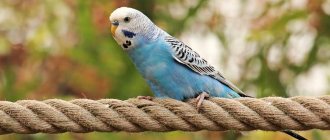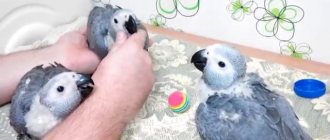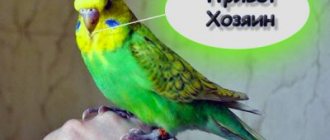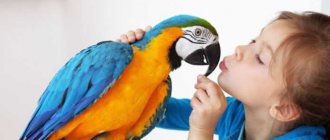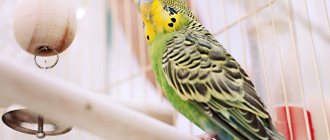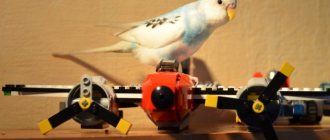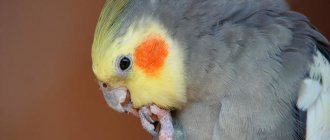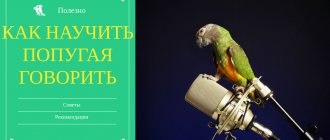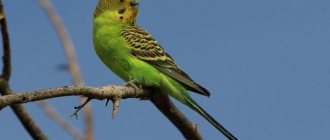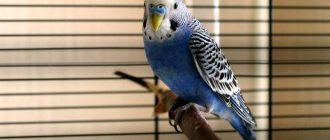Budgerigars do not have vocal cords. They make sounds using the lower larynx, which is located in the thoracic region. The laryngeal muscles and membranes stretch and contract, allowing birds to produce sounds. With their help, wild parrots communicate with each other in a flock, and domestic parrots can imitate human speech.
Parrots do not understand the meaning of words and the meaning of phrases, but they are good at capturing the intonation of the voice and all the sounds of the outside world. Birds have a well-developed memory, they remember dozens of words, and over time they can put them into sentences. To teach a pet parrot to speak, you need to be patient, learn all the intricacies of the process, and follow the rules of training.
Optimal age for training
Budgerigar chicks leave their parent's nest after 1-1.5 months from the date of birth. At this age, the young animals are already free to fly out of the cage and can feed on their own. From this moment on, it is a favorable time to train your pet.
The period of active development usually lasts up to 3.5-4 months, after which the level of concentration begins to gradually decrease. At six months, young birds can already breed, and by 10-12 months they become sexually mature adults. It will be more difficult to train them at this age; you will have to spend more time and effort.
You can find out how young a pet is by looking at the distinctive features of young parrots, namely:
- wavy lines on the head begin from the nose (after the first moult at 3 months, the wavy lines near the beak disappear);
- dark spots near the throat are indistinct, with blurred edges;
- eyes black, without a round white rim;
- the cere (the area above the beak) should be a single color, usually pale pink, blue or purple;
- the tip of the nose is dark or black (after 2 months it begins to lighten);
- the skin on the paws is almost smooth, without convex scales;
- the tail and wing feathers are short.
These signs are enough to understand that the bird is young. If the parameters do not match on at least one point, there is a risk of purchasing an adult parrot.
You cannot begin training immediately after arriving in the house. The bird needs to be given time to get used to its new home and environment. The adaptation time takes on average 2-4 weeks. When close contact has been established, the parrot has become tame and flies freely out of the cage, you can begin training.
Can a budgerigar start talking within 24 hours?
Talking budgies are not as common as Jacos or Macaws with similar talents, and they take longer to train . Teaching a bird its first word will require more than one lesson and a lot of diligence on your part, so be patient. Usually, budgies talk after 3-5 months of regular training, but your budgie may be faster or, conversely, slower. The first word should not be expected earlier than in 2-3 months, but further learning will progress at a more pleasant pace.
For the first day, a good dynamic will be the fact that the parrot listens to the word you say. Sometimes he will open his beak slightly or respond to your word with some kind of sound of his own. If this happens on the first day of training, you won’t have to think about how to quickly teach your budgerigar to speak - your bird has talent! Just keep in mind: you cannot start training a parrot immediately after purchasing it, since it is not yet used to you and has not accepted you into the “flock”. Put aside your studies and gain his trust first. The first lessons can begin after 1-2 weeks.
Abilities depending on the sex of the parrot
Long-term observations have shown that males learn to speak faster than females. This is due to the way of life of parrots in their natural environment. In the wild, males are active in order to find their mate and attract its attention. The females only have to make a choice and then take care of the chicks.
Domestic birds have adopted this behavior from their wild counterparts. Males are more energetic and inquisitive, so their learning usually goes faster. But the structure of the throat is identical in both sexes, and females are also able to speak well. “Girls” may require more time to study, but they pronounce words more clearly and distinctly than males.
Often the duration of classes and the result depend not on the sex of the bird, but on its character and abilities. There are many naturally gifted parrots. They have a tenacious memory, record frequently repeated words, and begin to repeat them without any training.
At what age should a budgie be taught to talk?
In fact, when we collect information on how to teach a budgerigar (boy or girl) to speak at home, we also want to get an answer to the question: “Can it be done?” Am I late with my studies?
Indeed, a young budgerigar repeats words from its owner faster and easier than older parrots. The most optimal age is considered to be the period of time that begins on the 35th day from the day the chick leaves the nest and lasts up to three or four months . In the sixth month, the parrot's learning abilities slow down and to achieve results he will need to put in more effort and repeat each word he learns many times.
Training rules
The main key to success is a trusting relationship with your pet. He should get comfortable in the house, freely fly out of the cage and be willing to be held. Then he will perceive classes as an opportunity to socialize or play. There are a number of rules that will help create the right atmosphere and achieve quick results:
- You need to exercise with your pet when he is healthy, fed and in a good mood. If the parrot is restless, chirping and flapping its wings, it is better to postpone training.
- There should be only one parrot. When there are brothers in the cage, they will communicate with each other in their “bird” language. The birds simply will not pay attention to the owner with his lessons.
- During classes, you need to remove the toys and create silence in the room. Extraneous noises and objects should not distract the bird. Be sure to remove mirrors near the cage - parrots perceive their reflection as a neighbor.
- Start small. Pet “talkers” love sibilant sounds, the letter “r” and voiceless consonants. Of the vowel letters, “o”, “i”, “e”, “a” are easier for them. Choose a short simple word (maximum of 2 syllables). Taking this data into account, you need to choose a nickname for the bird; it’s better to start training with it.
- Exercise daily, preferably in the morning and late afternoon. Lesson time is 5-10 minutes. If the bird listens, tilts its head to the side and tries to make sounds, it is interested, you can study longer. You need to know that what is more important here is not duration, but regularity. It’s better every day for 5-7 minutes than every 3 days for half an hour or more.
- Pronounce the words not loudly, but clearly. Parrots love high pitches, but are frightened by sharp sounds. You can attract women and children - birds perceive their timbre of voice well. It is important that at first someone from the family teaches. When the habit appears, then take turns doing it.
- You can sometimes use voice recording. But when listening, you need to be close to your pet so that contact is not lost. Otherwise, he will quickly begin to perceive the written words as background and will lose interest.
- Monitor your state of mind. The pet senses when the owner is irritated or anxious, and begins to worry too. In such a mood, there will be no benefit from studying; it is better to postpone studying until calm is restored.
- Regardless of the result, the bird should be praised and encouraged. Birds subtly pick up a gentle voice and remember the connection when they receive a treat after class. In the future, they begin to enjoy the lessons and study more willingly and longer.
You should try to accompany everyday actions with the same short phrases, always mentioning your nickname. Very quickly, parrots associate events with sounds, and then reproduce them. Often the words “eat”, “water” or the name of a pet become the first in their dictionary.
The nickname should be simple and short, with hissing sounds. The simpler the name, the faster the bird will begin to respond to it, and then willingly repeat its nickname.
Chatty boys and stupid girls
There is an opinion that it is impossible to teach parrot girls to talk. Actually this is not true. Both girls and boys eventually begin to talk, and the girls pronounce their words more clearly and understandably.
All parrots, regardless of gender, have the same structure of the sound apparatus, the peculiarity of which is the absence of vocal cords.
The sounds that budgies make are formed in the lower larynx, so the bird doesn’t even need to open its beak to talk; it is a natural ventriloquist. In the chest cavity there is a kind of chamber with external vocal membranes. Parrots have four sound sources - modulators, versus the usual two, which helps them successfully imitate human speech.
Males by nature are obliged to attract attention, to show themselves in all possible glory, including conversation. Females are passive, they do not need to win fans - they simply choose the best and do not bother too much about demonstrating skills. Their calling is eggs, and then chicks. Therefore, the female usually begins to speak later than the male, which became the reason for the myth about the lack of intelligence of female parrots.
You can achieve the favor of a budgerigar and reveal the conversational talent of a cute feathered friend with patience and affection. There is no need to wonder in vain: do female budgerigars talk? You need to love and train them regardless of gender, and sometimes even age.
Learning process
The first step to success is choosing the right time to study. The schedule must suit both parties. The parrot should be well-fed and active, and the “teacher” should be free from personal affairs. In the future, try to adhere to the established regime - the bird gets used to the activities and tunes in to communicate. Scheduled lessons help you achieve quick results.
The educational process should proceed as follows:
- Clear the cage of toys and mirrors. If the parrot likes to sit on your hand, take off your watch and jewelry so as not to distract its attention.
- Ensure silence in the room.
- Make eye contact with your pet, make sure he is interested and focused.
- Quietly but clearly repeat the chosen word (preferably a name), pausing for 2-3 seconds. Such gaps are needed so that the parrot can record new information.
- Closely monitor your pet's behavior. If he looks at his lips, his head is tilted to the side and his beak opens, then he is interested, you can continue. When he turns his head and flaps his wings, the lesson must end.
- Give a treat, gently praise and pet the pet, finally repeating the word being learned several times.
The bird gets used to regular exercise in a few days, then the training time can be set according to its mood. On some days, the “student” loses interest after just 5 minutes, and on other days he is ready to listen to the lesson for 20-30 minutes. You must act according to his behavior.
The first word is difficult. It may take from 2 weeks to 3 months, the speed largely depends on the abilities of the bird. When this stage is passed, the parrot learns the next words easier and faster. After 10-12 months, many already speak phrases of 3-5 words.
The teaching method does not require special skills and knowledge. To achieve results, you need to stock up on kindness and patience. Parrots are inquisitive and responsive, they are ready to learn new things if they are fascinated by the process.
The memory of birds is tenacious, but short. The words that the pet has learned must be repeated. Without regular practice, they forget the material they have learned, and it will be much more difficult to teach an adult to speak again.
The easiest way to get your parrot to talk
Teaching a parrot words is based on constant repetition. Say the right word every day, looking at the parrot (so that he understands that you are addressing him). At the same time, the parrot should look at your mouth (if it does not do this, turns its head or studies items of clothing, the view outside the window, then it means that it is not in the mood to engage, there is no need to pester it).
On average, it is better to allocate 15–20 minutes a day to repeat phrases (they can be divided into 5–6 sessions). In the first days, the parrot may just watch silently - this is normal. It is a good sign if after 2–4 weeks the bird begins to respond to the repeated word by chirping. After 5–8 weeks, imitation should appear (the bird begins to make sounds that are not yet similar to the word being studied) - praise the bird for the correct actions and, of course, give a treat. Over time, the bird will begin to put together words from imitating sounds, remember them and constantly pronounce them without your reminder.
The key to successful training is to motivate the parrot with a treat, which he will receive if he does everything correctly.
Video: visual instructions for teaching birds words
Is training birds using audio recordings effective?
On the Internet you can download special applications for training parrots. There is nothing special about them - they simply repeat selected phrases in a circle. The only plus is that you can set a timer. The system works as follows: the phone is left next to the cell, and you can safely go about your business or work. At the time intervals you select, the device will turn on itself and begin to speak words to the parrot.
Examples of Russian-language applications for teaching birds: “Phrasebook for parrots”, “Conversational genre for parrots”. These programs first make the screen flash to get the feathered student's attention. Then the phrase is repeated (the duration and pauses are optional). The range of the proposed “set” mainly includes well-known expressions and songs from cartoons and Soviet films, which are easy to learn and sound funny from the lips of a feathered pet.
You can replace the application with a regular audio recording. It is enough to speak the necessary phrases into the recorder, and then play the recording for your parrot. The disadvantage of this method is the lack of personal contact with the bird - it does not feel its owner, it has no urge to imitate him. In addition, the bird will not receive any reward if it starts repeating words, which means it will not have motivation.
When the parrot is not alone
If there is more than one parrot in the house, you need to deal with each one separately. The training process should take place in an isolated room so that other birds do not distract from the training. Parrots that live with their fellow parrots take longer to learn to speak than those that live alone. And most often they ignore human speech - they have enough communication with their relatives.
The result is successful when a pair is added to an already talking parrot. It is better if the female learns the words, and a male is placed with her. Then the “groom” tries to please his girlfriend and begins to imitate her. The female may also begin to repeat the words after the male, but it usually takes her longer.
Does gender influence predisposition to learn?
It is believed that heredity works well in parrots: speaking parents pass on their abilities to their chicks. It is unlikely that anyone has verified this statement, but there is no reason not to believe it.
Speech is produced by both males and females. The former are faster and more active, the latter do not show much attraction to human language for a long time. Therefore, they usually buy a young boy.
The influence of the sex of a parrot on the ability to speak
How to teach an adult parrot to speak
The learning process for an adult parrot is the same as for a young one. The only difference is that it will take more time. Especially for birds who have had negative experiences in the past. They are often wary and fearful. It is difficult for them to adapt to the new home and begin to trust its residents.
It is difficult for such “wounded” birds to even get close to a person, so first they need to be accustomed to the situation. When the pet understands that he is loved and protected here, then you can carefully and unobtrusively begin to learn the first word. You can wait 4-6 months or more for results. The main condition is not to force things and practice regularly.
The age of a bird is not always the determining factor in its ability to speak. It is important that at first the pet is alone in the cage, otherwise he will devote all his time to his other half.
What types of parrots learn faster?
The fastest-learning varieties of parrots include:
- Amazon. Experts believe that these birds learn spoken language faster than all other large representatives of the family. They are able to remember and reproduce 50-60 words.
- Budgerigars are the fastest learning small species. Vocabulary is often limited to 10-20 words, pronunciation is unclear.
- Corella. Talking cockatiels are very popular among bird lovers. On average, their vocabulary reaches several dozen words.
- Macaw. The vocabulary is very low - up to 20 words. But scientists have found that macaws are the smartest of the parrots. They are able to connect words and events, build an associative chain of thinking.
- Cockatoo. Speech training of representatives of this genus leads to the fact that birds begin to pronounce words well and legibly. Their vocabulary can include up to several dozen words.
- Jaco. If a bird lover wants to get a 100% talking parrot, then this is the choice for him. These birds are distinguished by the most developed speech abilities of all members of the family. They can remember and reproduce over 100 words and speak in phrases. The intellectual level of the Gray Gray is very high and corresponds to the level of a five-year-old child.
What not to do while studying
Wrong actions can forever discourage a parrot from mastering speech techniques. To avoid annoying mistakes, you must follow the following instructions:
- do not torment the bird with lessons when it is sick, anxious or hungry;
- do not conduct classes in a bad mood;
- do not choose complex words and phrases, start learning with a simple word;
- do not raise your voice at your pet, do not scold him and communicate only in a gentle, friendly tone;
- Do not teach a lesson with the TV on or listening to music;
- do not ignore your pet’s wishes if he clearly makes it clear that he is tired and does not want to exercise anymore.
It is very important to observe the parrot. By his behavior, he often demonstrates his willingness to communicate unscheduled. If a bird sits on your hand or shoulder, seeks attention, or puts its beak on its lips and mutters, you need to willingly support the game and “talk” with your pet. The more time you can spend together, the faster he will talk.
We continue to teach Volnistik conversation
During training, you need to pay attention to your intonation. Birds perfectly sense a person's mood. So, you need to talk to birds emotionally (kindly, kindly), but not shout - this will scare away the parrot. And monotonous speech can quickly get boring for them.
It is worth paying attention to the reaction of a budgie to certain words. If he gets worried, starts running fussily from side to side, or reacts in some other way, then this word is like a signal. It is better not to say it again during training.
Exercises with budgies should be enjoyed. Organize activities in the form of a conversation, that is, treat your pet as if you were a small child.
It is necessary to pronounce a word or phrase at least ten times during the entire lesson, but do not mindlessly jabber. You always need to maintain emotional intonation so that the parrot is interested in listening. The parrot expresses its interest by its attentive gaze, following you during training, and by fluffing its feathers.
It is important to notice the budgerigar's attempts to speak and reward his efforts with some kind of treat. This will encourage the bird to repeat the learned word over and over again. At first, the wavy will simply open its beak, watching you speak. Then he will try to repeat the sound that he heard from you earlier.
You cannot scold a bird when it fails or is simply silent. Patience is important in training, and such emotional outbursts will only further push the bird away from classes and the desire to speak.
In order for a budgerigar to learn to say, for example, the word “delicious” when feeding, you need to repeat this word exactly when you put food in the feeder. If you want your feathered pet to say other phrases, in other situations you must also repeat those words that you would like to hear from the parrot later.
Budgerigars that have already learned to speak several words tend to form new words by swapping syllables in one word or syllables in different words. For example, from the phrase “Roma, hello,” the parrot comes out “roaring.”
It is worth noting that parrots remember rhyme well. Try to choose a rhyme in the form of a simple word for each word that you want to teach your pet.
Of course, live communication with a parrot during classes is effective, but in some cases, machine reproduction of your voice is also useful. For example, a voice recording can help if you are away from home for a long time. After all, training with a parrot should only be carried out by one person whom the bird trusts.
Words and phrases for parrot
An important first step is to choose the right name. There are many suitable nicknames for birds. In addition to the famous “Kesh”, “Gosha” and “Roma”, the following nicknames are popular:
- Richie;
- Shusha;
- Grisha;
- Chicha;
- Shura;
- Archie;
- Tosha.
When the parrot has learned to say its name, a word denoting an action is added to it. It is better to choose words that are spoken several times daily. For example, these are: “hello”, “eat”, “sleep”, “drink”, “swim”, “walk”, “water”, “toy”.
After mastering 2-word phrases, you can complicate the task. Popular phrases that are easier for parrots to learn:
- Everything will be fine;
- Good afternoon;
- do not make noise;
- Good night;
- I like you;
- How are you doing;
- look for a gift;
- behave yourself;
- Tosha is good;
- How are you doing.
Budgerigars are intelligent and talkative by nature. When they overcome the difficulties in learning the first words, these birds are later able to read poetry or sing songs (“I play the harmonica...”, “Antoshka, let’s go dig potatoes...”, “I walked quietly, walked, walked, and found a pie...” and others).
Budgerigars are able to imitate the murmur of water, the meowing of a cat, or the barking of a dog. To teach your pet to talk, you need to establish a warm, trusting relationship with him and exercise regularly. Parrots always respond to kindness and care, and one fine morning the long-awaited “Hello!” will surely be heard. or “Everything will be fine!”
Tips and tricks
When parrots say words or combinations of words, this does not mean that they understand the meaning of what was said. Birds simply imitate a sequence of sounds.
Experts advise that after the first 10–12 lessons you associate the pronunciation of a task word with a specific situation. It is better to choose actions that are repeated day after day. For example, a greeting at a meeting, an invitation to a meal or a swim (“eat”, “swim”, “hello, Kesha”).
Experienced breeders confirm that the main success factors are:
- patience;
- competent approach;
- motivation;
- lack of stress;
- regularity of training.
To consolidate the achieved results, a mirror removed from the cage during training helps a lot. The parrot, who is satisfied with the communication with the owner, immediately begins to “tell” the attribute placed in its usual place about its successes and repeat the memorized sounds.
Birds mistake their reflection for a cute relative, and are happy to share the news with him.
